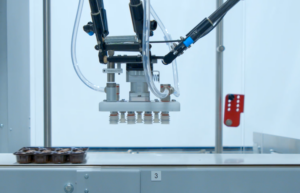Artisan-style confectionary picked and placed with ultimate care and precision

Naked chocolates present an interesting challenge for vacuum gripper manufacturers. There has to be a perfect balance of delicacy, speed and accuracy to ensure maximum throughout and optimal quality.
Honolulu-based Hawaiian Host Group is the largest manufacturer of chocolate-covered macadamias in the world. Its products are associated with the Japanese word ‘omiyage’, meaning: a thoughtful souvenir from paradise to gift to friends and family, as such, quality and appearance are of paramount importance. But Hawaiian Host must also balance these artisan demands with modern business requirement for efficient and waste-free production, which is why it employs advanced technology in its packaging operations.

Once such project, backed by significant investment, has seen a huge packaging line being designed and installed, which will see over 1,500 chocolates per minute being packed precisely, positively and delicately in an array of different packaging formats.
The turnkey line, developed by Italian end-of-line packaging specialists Cama Group , uses specially designed robots equipped with Gimatic grippers to pick three different types of naked chocolates from feed rows on a conveyor and then gently place them into PET trays that arrive in parallel from a de-nester. The chocolates’ quality, shape and position on the belt are determined using a special 3D laser scanner supplied by Univision.

Once each tray is full, they are loaded singly or in pairs (with a cushion sheet) into carton tray, before a lid is formed and tucked into the tray, the finished product being a completed box containing anything from four to 32 chocolates. The boxes are then fed through an X-Ray machine and check weigher before heading to a case packer at the end of the line.
Federico Tona, Country Sales Manager at Gimatic, explains: “The primary remit in this application was to handle all three styles of chocolate without damaging them, so delicacy was important. Engineers at Cama created the technical specification; they already knew the capabilities of our cylinders and asked us to redesign them to match the precise needs of this application.
“Our solution,” he continues, “was our OFL303 with integrated vacuum pumps. It is one of our standard products but modified to deliver a more compact solution. As well as saving energy thanks to localised pumps, the smaller size of the assembly means it has less inertia and can therefore be accelerated, traversed, and decelerated more rapidly.
“Its soft FDA-certified suction cups are ideal for this type of application,” Tona concludes, “with four bellows to adapt to the randomised shape and form of these naked products. The OFL303 also contains vacuum sensors, which can detect if a pick has been successful based on vacuum pressure. Any failures are immediately detected and fed back the controlling Rockwell Automation PLC.”

This turnkey line is a story of successful integration and partnerships. A Cama machine, using Univision vision systems and Gimatic grippers all working in harmony to meet the precise needs of a prestigious customer.
“The confectionary industry demands optimum efficiency,” according to Alessandro Rocca, Group Sales Director at Cama Group. “You can’t just stop a 1,500 ppm line due to problems caused by inferior equipment! Our adage is: ‘never stop the line unnecessarily and be as efficient as possible when it is running.’ And this counts as double, as phase two of this project will see another line going in.”
According to Chris Rabago, Director of Manufacturing at Hawaiian Host: “Clear communication and collaboration was essential, as equipment projects have a high number of variables, and it’s critical that an open dialogue exist around cost/benefit solutions as well as build decisions that may impact the equipment capabilities in the future. In respect to the technology, we look for an intuitive user interface, simple changeovers, and remote service support, which is especially important to our Hawaii-based production facilities, as it is often a challenge to quickly bring technicians onsite.”




